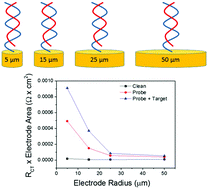Impedimetric measurement of DNA–DNA hybridisation using microelectrodes with different radii for detection of methicillin resistant Staphylococcus aureus (MRSA)†
Abstract
Due to their electroanalytical advantages, microelectrodes are a very attractive technology for sensing and monitoring applications. One highly important application is measurement of DNA hybridisation to detect a wide range of clinically important phenomena, including single nucleotide polymorphisms (SNPs), mutations and drug resistance genes. The use of electrochemical impedance spectroscopy (EIS) for measurement of DNA hybridisation is well established for large electrodes but as yet remains relatively unexplored for microelectrodes due to difficulties associated with electrode functionalisation and impedimetric response interpretation. To shed light on this, microelectrodes were initially fabricated using photolithography and characterised electrochemically to ensure their responses matched established theory. Electrodes with different radii (50, 25, 15 and 5 μm) were then functionalised with a mixed film of 6-mercapto-1-hexanol and a thiolated single stranded DNA capture probe for a specific gene from the antibiotic resistant bacterium MRSA. The complementary oligonucleotide target from the mecA MRSA gene was hybridised with the surface tethered ssDNA probe. The EIS response was evaluated as a function of electrode radius and it was found that charge-transfer (RCT) was more significantly affected by hybridisation of the mecA gene than the non-linear resistance (RNL) which is associated with the steady state current. The discrimination of mecA hybridisation improved as electrode radius reduced with the RCT component of the response becoming increasingly dominant for smaller radii. It was possible to utilise these findings to produce a real time measurement of oligonucleotide binding where changes in RCT were evident one minute after nanomolar target addition. These data provide a systematic account of the effect of microelectrode radius on the measurement of hybridisation, providing insight into critical aspects of sensor design and implementation for the measurement of clinically important DNA sequences. The findings open up the possibility of developing rapid, sensitive DNA based measurements using microelectrodes.



 Please wait while we load your content...
Please wait while we load your content...